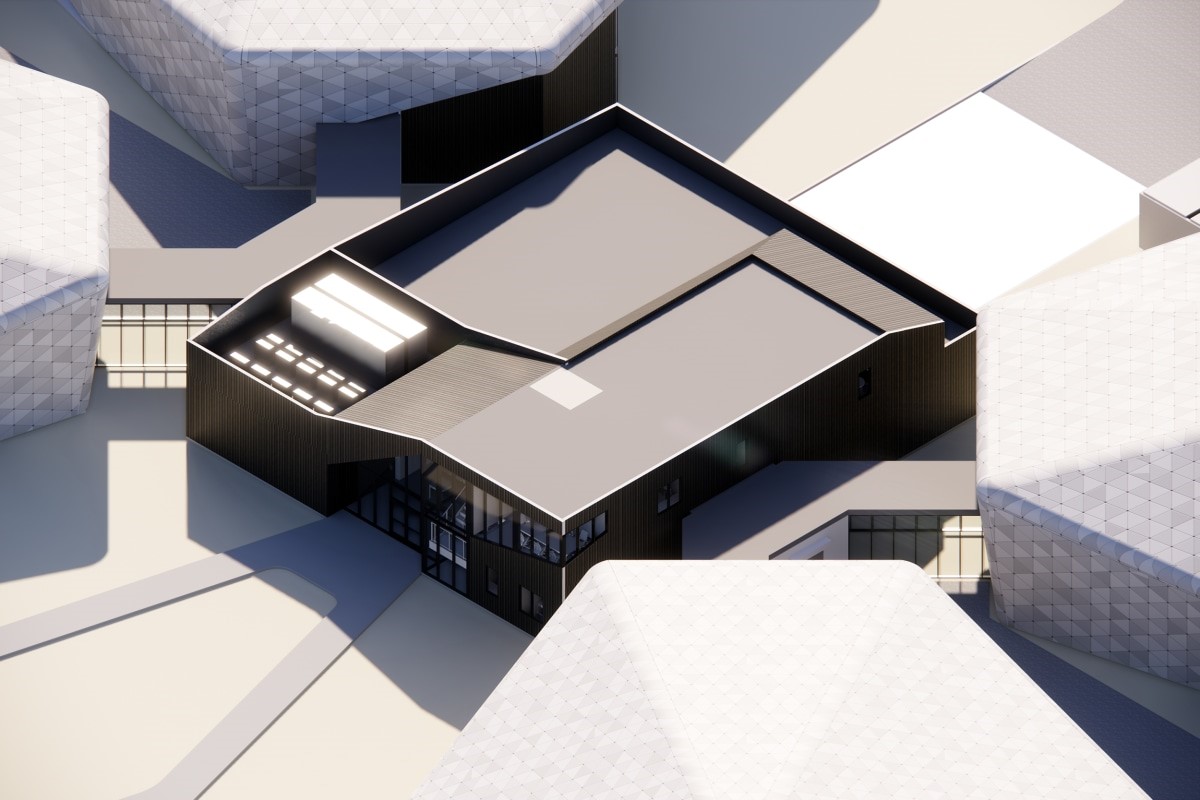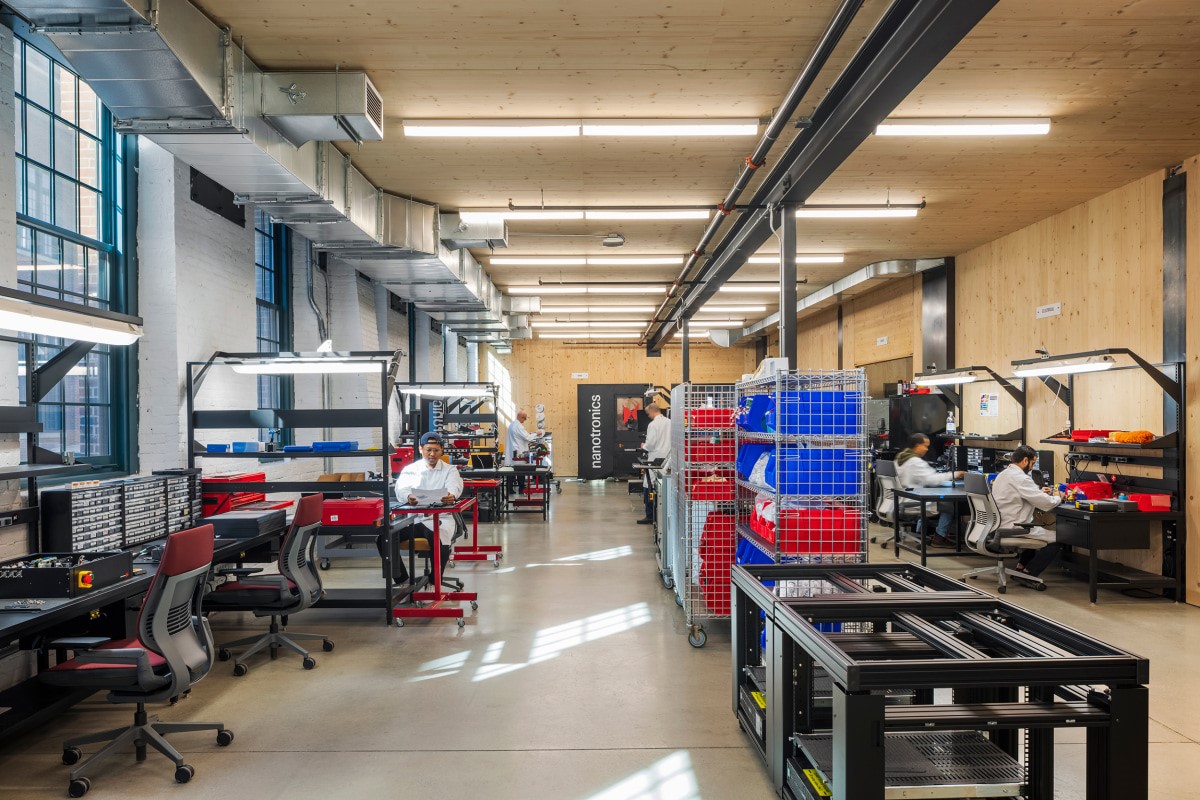A NY startup aims to build hundreds of chip factories with prefab parts and AI
To meet the world’s growing hunger for chips, a startup wants to upend the costly semiconductor fabrication plant with a nimbler, cheaper idea, one they believe can faster spread the manufacturing of the chips inside nearly everything we use: an AI-enabled chip factory that can be assembled and expanded modularly with prefab pieces, like high-tech Lego bricks.”
“We’re democratizing the ownership of semiconductor fabs,” says Matthew Putman, referring to chip fabrication plants. Putman is the founder and CEO of Nanotronics, a New York City-based industrial AI company that deploys advanced optical solutions for detecting defects in manufacturing procedures.
Its new system, called Cubefabs, combines its modular inspection tools and other equipment with AI, allowing the proposed chip factories to monitor themselves and adapt accordingly—part of what Putman calls an “autonomous factory.” The bulk of the facility can be preassembled, flat-packed and put in shipping containers so that the facilities can be built “in 80% of the world,” says Putman.
Eventually, the company envisions hundreds of the flower-shaped fabs around the world, starting with a prototype in New York or Kuwait that it hopes to start building by the end of the year.
“This has been a dream of mine since day one,” says Putman, who has a PhD in applied math and physics and began working in tech at the age of 8, for his parents’ manufacturing company. His father, John, “put the first personal computers on the factory floors back in 1982,” he says. It would take four more decades, and the confluence of the right technologies and geopolitical stakes, for something like Cubefabs to make sense. “It could only happen now,” Putman adds.
The world’s chip dependence has never been in sharper relief, with a spike in fab construction in the U.S. alone to the tune of hundreds of billions—a boost from the CHIPS and Science Act of 2022 and similar incentives around the globe, not to mention the growing geopolitical anxieties over the most advanced chips. (New chip restrictions on China by the Biden administration have raised the temperature of a global chip war, frustrating, among others, American chip makers.) Despite a recent deceleration in semiconductor demand, the global hunger for chips is expected to double in size by 2030. Meanwhile, the costs of fabricating them are skyrocketing. Moore’s law says that the number of transistors in an integrated circuit doubles every two years; Rock’s law says that the cost of a chip fabrication plant doubles every four.
By leveraging Nanotronics’ expertise in materials and automation—and prefab construction—and by standardizing and shrinking the factory, Putman sees a way to upend the prevailing paradigm, which preaches a single one-big-size-fits-all quest for economies-of-scale. “If you could build a lot of small factories quickly, and in a lot of places, you can achieve scale much quicker,” he says.
Designed in collaboration with architects Rogers Partners and Arup, each Cubefab looks like a cyberpunk clover, with a service “cube” at the center and modular fabs, each of which can fit two clean rooms, branching out like leafs. These are small fabs—known as nano fabs in the industry—capable of a few hundred wafer starts per month; A giant megafab that Taiwan Semiconductor Manufacturing Company is building in Arizona is aiming for 20,000 wafer starts per month when it fully opens in 2025, after multiple delays and cost overruns.
Nanotronics says a single Cubefab installation could start at one acre with a single fab, and grow to a four-fab, six-acre footprint. Each fab could be built in under a year, the company says, with a four-fab installation estimated to cost under $100 million. Nanotronics declined to disclose how much it has raised for the project, but Putman says the company has previously raised $170 million from investors, including Peter Thiel and Jann Tallin, the Skype cofounder.
In addition to an unnamed Kuwaiti customer, Putman says Nanotronics is discussing possible partnerships with automakers and industrial companies, and is targeting locations in the Middle East, Germany, Spain, and in three U.S. states. Its potential customers, he says, are “any company that wants to be vertically integrated.”
How and where the world’s next generation of chips will be made has become an open question, but reshaping a $500 billion industry won’t be easy. Semiconductors are the basis of the advanced chips that power the device you’re reading this on, and the most powerful AI systems, as well as the more basic chips crucial for a wide range of users, including a growing renewable-energy industry. While they were invented in the U.S., a relentless demand for efficiency in a volatile market has pushed most of the production of semiconductors to East Asia, with the most advanced chips made only in Taiwan by TSMC, now the world’s most valuable semiconductor maker.

Governments and chip companies have sought to diversify their supply chains beyond Asia, but the costs of building new fabs, especially in the U.S. and Europe, are eye-popping. The CHIPS Act includes $39 billion over five years in direct subsidies for U.S.-based chipmakers, but that’s just slightly more than what just one of the biggest chip firms devotes to capital spending in a year.
Putman points to the giant fabs TSMC and Micron are building in Arizona and upstate New York, among a slew of under-construction U.S. fabs by Intel, GlobalFoundries, Texas Instruments, and Samsung Foundry. “They take five years to build, they’re huge, they take up a whole city block, the infrastructure is enormous,” he says. “You can’t keep up with Moore’s law if it’s exponentially more expensive to build a fab.”
Despite all the attention (and sanctions) on AI chips, the world is growing increasingly hungry for the more common chips that are used in everything from LEDs and lasers to cars to phone chargers and the data centers that help fuel AI. Ford said earlier this year that its inability to source enough chips led to a quarterly-sales shortfall of 100,000 vehicles.
It’s these kinds of high-power, trailing-edge devices that Cubefabs will be designed to build initially, on intermediate-size 200 mm wafers. Instead of silicon-based chips, Cubefabs will produce what are called compound semiconductors, using a newer substrate, gallium oxide, which promises manufacturing efficiencies and more rugged, energy-efficient devices. That includes, says Putman, “the specialty chips that are either in demand, in short supply, or have not been optimized before, so they haven’t been cost efficient.”
A system of prefab nanofabs producing newer chips like these could help companies or academic labs take more control over their supply chains, allowing them to more quickly adjust supply according to demand, and insulate themselves from a market given to frequent shocks and shortages. “Making the process quicker, cheaper, more efficient—that allows numbers to be tweaked faster, decreasing or increasing supply as demand wanes,” says Bob Gelfond, founder and chairman of MagiQ Technologies, an early quantum-computing company, and a venture investor, including in Cubefabs.
John VerWey, a national security adviser who studies semiconductors at the Department of Energy’s Pacific Northwest National Laboratory, says being able to build a wide variety of chips at relatively low scale flies in the face of the prevailing chipmaking ecosystem, but “there’s a need for it, certainly.”
VerWey estimates there are currently about 150 to 200 of these nanofabrication facilities in the U.S., most of them within university research labs. Facilities capable of producing more boutique chips for commercial uses could have positive effects for supply chain security, and could help more quickly prototype devices, helping bridge a gap between basic and applied research and real-world applications. “People have been enthused by the prospect of figuring out how to make it affordable to run these sorts of nanofabs for a long time,” he said.
Each Cubefabs will be sold under a franchise model, whereby Nanotronics orchestrates supplies and prefabrication, installs the fab according to its owner’s needs, provides service and monitoring, and takes licensing fees, as well as a share of revenue from the fab’s output. The idea helps Nanotronics capitalize the project and lessens the financial and skills burden on customers, “which enables them to do this,” says Alice Globus, the company’s chief financial officer. “And it keeps us involved the whole time without ownership of the fab itself.”
“We think of it as a deliverable,” says Putman. “The way that we would deliver an instrument, but we’re delivering an entire fab now.”

Jack Dreifuss, the founder of Impatient Ventures and a Cubefabs investor, says that if Nanotronics can deliver on its promise, it would become “one of the most important American companies, one of the most important in the world.”
“If they can build these facilities at this cost with these resources with this efficiency for something as complex as a semiconductor chip,” he says, “it fundamentally then turns all this manufacturing upside down.” With the right mix of AI, robotics, infrastructure, computer vision, and materials, Cubefabs could be used to make “frankly, most of everything else.”
It’s still a big If. To defy the existing laws of semiconductor economics, Nanotronics will still need to show it can bring a range of ideas and technologies together into a single workable system. Pulling it off will require not only prefabricating many of the components and piping needed for a fab, but also working with potentially dozens of partners on sourcing the other machinery required for chipmaking: deposition, coating, photolithography, cleaning, and other tools, and navigating the environmental and regulatory complexities of fab building.
Constructing a fab and installing all of its complex parts, especially in the U.S., tends to be more complicated and more costly than expected. “It’s straightforward to build a fab shell and have a structure in place,” says VerWay, “but the hard part is then partnering with everyone who participates in the supply chain.”
++
For Putman, the concept of a network of robotic factories is a dream that dates back to his childhood obsession with Star Trek, but it didn’t begin to seem feasible until Nanotronics assembled its own manufacturing facility. In 2019, the company began converting a vast former ship factory at the Brooklyn Navy Yard into its new headquarters, using prefabricated sections of steel and cross-laminated timber. The first section of the 44,000-square-foot facility, designed by Rogers Partners, took only nine months from groundbreaking. “So we gained confidence that prefabrication was possible in that way,” says Putman.
To begin sketching out the Cubefabs idea, Nanotronics tapped Rogers and Arup for help with design and climatic studies that could identify fab designs practical for a range of climates, from hot Middle Eastern desert to cold upstate New York. An internal design team refined the infrastructure plans so they can meet various construction codes and regulatory environments across the globe, while engineers began working on new combinations of hardware and machine-learning software.
Large chip fabs are already highly automated, but Putman sees the automation of smaller, easier-to-build fabs opening up opportunities in places where skilled workers aren’t readily available. The shortage of skilled chip workers is pervasive, even across the U.S. TSMC in July delayed the opening of its $12 billion plant in Arizona because it said it couldn’t find enough skilled workers to install the fab’s equipment; more recently, it said half of the plant’s employees will need to come from Taiwan.
A single automated Cubefab will need only about 30 people to operate, “and they don’t have to be semiconductor experts,” says Putman. “AI takes away that need for that specialization that you would normally need in a fab.”
That automation, he hopes, can also help those with more specialized skills spend more time inventing chips rather than inspecting them. “These are creative people that should be designing, doing other work that’s necessary for the next generation of materials and devices,” he says.
Automating small-scale chipmaking could be especially appealing in the Middle East and other regions where chipmaking is still nascent, says Anwaar AlMahmeed, a Kuwait-based investor in Cubefabs. Just think, she says, of the boost that SpaceX gave to the commercial space industry. “It’s exciting because you’re letting in more people who can bring in different perspectives and different advantages. And that means you’re going to have more innovation.”
The choice of gallium oxide, which hasn’t yet been commercialized as a chip substrate, could pose another challenge. The decision was the result of a set of limitations the company set for itself, Putman says, including being able to fit a fab into a small, adaptable, prefabricated design, as well as “constraints that we know are problems in the world.”

Gallium oxide is more efficient than other compound semiconductors, with about five times more efficiency than silicon, which also allows for lower weight and reduced battery wear. It can withstand high heat, which makes it more versatile, too. Gallium can also be grown in bulk, and poses fewer manufacturing and resource demands, like obviating the need for ultra-pure water. With gallium oxide, “we don’t use as many gasses and materials and don’t have the same kind of waste,” says Putman. “It’s only a twelve-step process instead of hundreds of steps.”
The drawback of compound semiconductors is that they are highly prone to defects. This is where AI is critical, says Putman, through the inspection tools that have become Nanotronics’ specialty. The tools, nSpec and nControl, help monitor defects as well as conditions like pressure, flow rates, gasses and temperatures; in a Cubefab, this monitoring would apply throughout the manufacturing process. With machine learning, the system is “like a cybernetic being that exists above the process and makes changes dynamically,” says Putman. Data from across a network of Cubefabs can help balance capacity and improve the operation of each individual fab. “The more we have, the better each facility will get. It’s an ever-evolving organism.”
Putman also hopes automation will help further reduce the environmental impact of an industry that’s notoriously resource-intensive and produces thousands of tons of waste a year, much of it hazardous. “Because you have the AI fixing the material and the device before it’s manufactured, you have less waste of the final material,” he says.
Globus acknowledges that challenges related to construction and procurement would bewere inevitable at the beginning, but says she’s confident in Nanotronics’ ability to manage a wide range of suppliers and contractors. “We’re partnering with experts that have done this thousands of times for other types of applications.”
Despite the challenges, the risk is worth it. “There’s very few times when you see technology that will change the world, and I think right now we’re at the cusp of that,” she says. “I think in three years, the world will be a completely different place.”
“And,” Putman adds, “we need one year for a Cubefab!”
(12)



